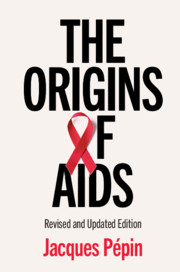Book contents
- The Origins of AIDS
- The Origins of AIDS
- Copyright page
- Dedication
- Contents
- Figures
- Maps
- Acknowledgements
- Note on Toponymy
- Abbreviations
- Introduction
- Chapter 1 Out of Africa
- Chapter 2 The Source
- Chapter 3 The Timing
- Chapter 4 The Cut Hunter
- Chapter 5 The Scramble for Central Africa
- Chapter 6 Tropical Boom Towns
- Chapter 7 The Oldest Profession
- Chapter 8 Injections and the Transmission of Viruses
- Chapter 9 The Legacies of French Colonial Medicine
- Chapter 10 The Legacies of Belgian Tropical Medicine
- Chapter 11 The Other Human Immunodeficiency Viruses
- Chapter 12 From the Congo to the Caribbean
- Chapter 13 The Blood Trade
- Chapter 14 A Long Journey
- Chapter 15 Globalisation
- Chapter 16 A False Villain, a Genuine Hero
- Chapter 17 Epilogue
- References
- Index
Chapter 7 - The Oldest Profession
Published online by Cambridge University Press: 05 January 2021
- The Origins of AIDS
- The Origins of AIDS
- Copyright page
- Dedication
- Contents
- Figures
- Maps
- Acknowledgements
- Note on Toponymy
- Abbreviations
- Introduction
- Chapter 1 Out of Africa
- Chapter 2 The Source
- Chapter 3 The Timing
- Chapter 4 The Cut Hunter
- Chapter 5 The Scramble for Central Africa
- Chapter 6 Tropical Boom Towns
- Chapter 7 The Oldest Profession
- Chapter 8 Injections and the Transmission of Viruses
- Chapter 9 The Legacies of French Colonial Medicine
- Chapter 10 The Legacies of Belgian Tropical Medicine
- Chapter 11 The Other Human Immunodeficiency Viruses
- Chapter 12 From the Congo to the Caribbean
- Chapter 13 The Blood Trade
- Chapter 14 A Long Journey
- Chapter 15 Globalisation
- Chapter 16 A False Villain, a Genuine Hero
- Chapter 17 Epilogue
- References
- Index
Summary
Chapter 7 reviews the development of different types of prostitution driven by the gender imbalance in the nascent cities of central Africa, especially Léopoldville and Brazzaville. It describes how this core group played a key role in the dynamics of all sexually transmitted pathogens, including HIV. Initially, ‘soft’ prostitution, where ‘free women’ had three or four regular clients who visited them on a weekly basis, had low potential for amplifying HIV. After the turmoil of the Belgian Congo’s independence in 1960, however, a new type of prostitution emerged, where sex workers had intercourse with three or four different men every day, or more than 1,000 per year, which enabled the sexual amplification of HIV. The life and work of Suzanne Comhaire-Sylvain provide an early example of the links between Haiti and the Congo. She was a Haitian anthropologist who studied prostitution in Léopoldville and described the profound changes in the sex trade in the early 1960s.
Keywords
- Type
- Chapter
- Information
- The Origins of AIDS , pp. 124 - 152Publisher: Cambridge University PressPrint publication year: 2021

